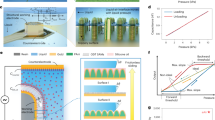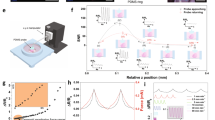Abstract
The ability to measure pressure changes inside different components of a living cell is important, because it offers an alternative way to study fundamental processes that involve cell deformation1. Most current techniques such as pipette aspiration2, optical interferometry3 or external pressure probes4 use either indirect measurement methods or approaches that can damage the cell membrane. Here we show that a silicon chip small enough to be internalized into a living cell can be used to detect pressure changes inside the cell. The chip, which consists of two membranes separated by a vacuum gap to form a Fabry–Pérot resonator, detects pressure changes that can be quantified from the intensity of the reflected light. Using this chip, we show that extracellular hydrostatic pressure is transmitted into HeLa cells and that these cells can endure hypo-osmotic stress without significantly increasing their intracellular hydrostatic pressure.
This is a preview of subscription content, access via your institution
Access options
Subscribe to this journal
Receive 12 print issues and online access
$259.00 per year
only $21.58 per issue
Buy this article
- Purchase on Springer Link
- Instant access to full article PDF
Prices may be subject to local taxes which are calculated during checkout




Similar content being viewed by others
References
Stewart, M. P. et al. Hydrostatic pressure and the actomyosin cortex drive mitotic cell rounding. Nature 469, 226–230 (2011).
Rand, R. P. & Burton, A. C. Mechanical properties of red cell membrane. i. Membrane stiffness+intracellular pressure. Biophys. J. 4, 115–135 (1964).
Strohmeier, R. & Bereiterhahn, J. Hydrostatic-pressure in epidermal-cells is dependent on Ca-mediated contractions. J. Cell Sci. 88, 631–640 (1987).
Kelly, S. M. & Macklem, P. T. Direct measurement of intracellular pressure. Am. J. Physiol. 260, C652–C657 (1991).
Whitesides, G. M. The ‘right’ size in nanobiotechnology. Nature Biotechnol. 21, 1161–1165 (2003).
Singhal, R. et al. Multifunctional carbon-nanotube cellular endoscopes. Nature Nanotech. 6, 57–63 (2011).
Tian, B. Z. et al. Three-dimensional, flexible nanoscale field-effect transistors as localized bioprobes. Science 329, 830–834 (2010).
Arlett, J. L., Myers, E. B. & Roukes, M. L. Comparative advantages of mechanical biosensors. Nature Nanotech. 6, 203–215 (2011).
Cross, S. E., Jin, Y. S., Rao, J. & Gimzewski, J. K. Nanomechanical analysis of cells from cancer patients. Nature Nanotech. 2, 780–783 (2007).
Balaban, N. Q. et al. Force and focal adhesion assembly: a close relationship studied using elastic micropatterned substrates. Nature Cell Biol. 3, 466–472 (2001).
Vaziri, A. & Gopinath, A. Cell and biomolecular mechanics in silico. Nature Mater. 7, 15–23 (2008).
Fan, J. Y. & Chu, P. K. Group IV nanoparticles: synthesis, properties, and biological applications. Small 6, 2080–2098 (2010).
Tasciotti, E. et al. Mesoporous silicon particles as a multistage delivery system for imaging and therapeutic applications. Nature Nanotech. 3, 151–157 (2008).
Fernandez-Rosas, E. et al. Intracellular polysilicon barcodes for cell tracking. Small 5, 2433–2439 (2009).
Novo, S. et al. A novel embryo identification system by direct tagging of mouse embryos using silicon-based barcodes. Human Reprod. 26, 96–105 (2011).
Gomez-Martinez, R. et al. Intracellular silicon chips in living cells. Small 6, 499–502 (2010).
Born, M. & Wolf, E. Principles of Optics 6th edn (Pergamon, 1980).
French, P. J. Polysilicon: a versatile material for microsystems. Sens. Actuat. A 99, 3–12 (2002).
Myers, K. A., Rattner, J. B., Shrive, N. G. & Hart, D. A. Hydrostatic pressure sensation in cells: integration into the tensegrity model. Biochem. Cell Biol. 85, 543–551 (2007).
Ingber, D. E. & Tensegrity I. Cell structure and hierarchical systems biology. J. Cell Sci. 116, 1157–1173 (2003).
Borgnia, M., Nielsen, S., Engle, A. & Agre, P. Cellular and molecular biology of the aquaporin water channels. Annu. Rev. Biochem. 68, 425–458 (1999).
Spagnoli, C., Beyder, A., Besch, S. & Sachs, F. Atomic force microscopy analysis of cell volume regulation. Phys. Rev. E 78, 031916 (2008).
Finan, J. D. & Guilak, F. The effects of osmotic stress on the structure and function of the cell nucleus. J. Cell Biochem. 109, 460–467 (2010).
Pietuch, A, Brückner, B. R. & Janshoff, A. Membrane tension homeostasis of epithelial cells through surface area regulation in response to osmotic stress. Biochim. Biophys. Acta Mol. Cell Res. 1833, 712–722 (2013).
Tambe, D. T. et al. Collective cell guidance by cooperative intercellular forces. Nature Mater. 10, 469–475 (2011).
Trepat, X. et al. Physical forces during collective cell migration. Nature Phys. 5, 426–430 (2009).
DuFort, C. C., Paszek, M. J. & Weaver, V. M. Balancing forces: architectural control of mechanotransduction. Nature Rev. Mol. Cell Biol. 12, 308–318 (2011).
Jaalouk, D. E. & Lammerding, J. Mechanotransduction gone awry. Nature Rev. Mol. Cell Biol. 10, 63–73 (2009).
Fritsch, A. et al. Are biomechanical changes necessary for tumour progression? Nature Phys. 6, 730–732 (2010).
Wozniak, M. A. & Chen, C. S. Mechanotransduction in development: a growing role for contractility. Nature Rev. Mol. Cell Biol. 10, 34–43 (2009).
Acknowledgements
This work was supported by the Spanish Government grants TEC2009-07687-E, TEC2011-29140-C03-01 and SAF2010-21879-C02-01. P.V. was supported by Centro de Investigación Biomédica en Red de Diabetes y Enfermedades Metabólicas Asociadas–Instituto de Salud Carlos III (CIBERDEM-ISCIII). The authors thank M. Calvo of Centros Científicos y Tecnológicos–Universidad de Barcelona (CCiT-UB), M.T. Seisdedos (CIB), J. Monteagudo (Leica Microsystems S.L.) and D. Megias of Unidad de Microscopía Confocal-Centro Nacional de Investigaciones Oncológicas (CMU-CNIO) for their assistance with CLSM experiments and A. Bosch (CCiT-UB) for assistance with image processing. The authors also thank the cleanroom staff of IMB-CNM for fabrication of the chips.
Author information
Authors and Affiliations
Contributions
All authors discussed the results and contributed to writing the manuscript. M.D., R.G-M. and J.E. conceived and guided chip fabrication. Optical design and analysis was carried out by K.Z. The biological experiments were performed by A.M.H.P. and P.V., designed by A.M.H.P. and E.J.d.l.R., and planned and coordinated by T.S. R.G-M. performed the experimental characterization of the chips as well as data analysis. J.A.P. conceived and directed the project.
Corresponding author
Ethics declarations
Competing interests
The authors declare no competing financial interests.
Supplementary information
Supplementary information
Supplementary information (PDF 3994 kb)
Supplementary movie S1
Supplementary movie S1 (AVI 236 kb)
Supplementary movie S2
Supplementary movie S2 (AVI 205 kb)
Rights and permissions
About this article
Cite this article
Gómez-Martínez, R., Hernández-Pinto, A., Duch, M. et al. Silicon chips detect intracellular pressure changes in living cells. Nature Nanotech 8, 517–521 (2013). https://doi.org/10.1038/nnano.2013.118
Received:
Accepted:
Published:
Issue Date:
DOI: https://doi.org/10.1038/nnano.2013.118
This article is cited by
-
Colloidal robotics
Nature Materials (2023)
-
Cell Rover—a miniaturized magnetostrictive antenna for wireless operation inside living cells
Nature Communications (2022)
-
Intracellular detection and communication of a wireless chip in cell
Scientific Reports (2021)
-
Integrating magnetic capabilities to intracellular chips for cell trapping
Scientific Reports (2021)
-
Tracking intracellular forces and mechanical property changes in mouse one-cell embryo development
Nature Materials (2020)



